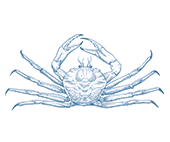




- Eat Less
Wild Caught
Region:
Commonwealth waters
- The term ‘Moreton Bay bugs’ refers to both the reef and mud bug, which are managed as though they were a single species. Although there is a lack of stock status information, there are no immediate concerns over the stock status of these species.
- Bugs are caught using otter trawls that operate over the seafloor. Trawling is conducted over sandy and muddy seafloors, and has a relatively low impact on the marine environment.
- Bycatch reduction measures are mandatory in these fisheries, and have reduced accidental turtle catches.
- The fishery interacts with threatened species, including critically endangered species of sawfish, sea snakes and pipefish. Although efforts have been made to reduce the impact of fishing on these species, catches remain significant although are not thought to be driving further declines in population numbers.
- Commonwealth Northern Prawn Fishery (45t in 2016)
The term ‘Moreton Bay bugs’ refers to two species, the reef and mud bug, both found throughout subtropical and tropical waters around Australia. Bugs are caught in a Commonwealth-managed trawl fishery that mainly targets prawns. The stock structure of either species of bug is poorly understood and no stock assessments have taken place. The stocks are partially protected by management measures such as non-retention of ‘berried’ or egg-bearing females and a restriction on the amount that can be caught.
Bugs are caught using otter trawls that operate mainly over mud and sand. Otter trawls operate over the seafloor when targeting tiger and endeavour prawns. This has the potential to cause significant habitat disturbance. Habitat types affected and are fairly resilient to disturbance and tend not to support sensitive marine communities, however, relatively little of the areas in which these fisheries operate is protected in spatial closures or marine parks.
Bycatch reduction devices (BRD) and Turtle Exclusion Devices (TEDs) reduce the amount of threatened and other species that are caught and killed in fishing gear. BRDs and TEDs are mandatory in all these fisheries and have been successful in reducing turtle deaths. However, threatened species bycatch remains an ongoing issue.
Catches of sea snakes remains high, although there is no indication that sea snake populations are declining as a result of fishing activity. Endangered sawfish, including the IUCN listed ‘Critically Endangered’ green and ‘Endangered’ dwarf sawfish are also caught every year, although it is complex to design modified fishing gear to reduce sawfish mortalities because the shape of their rostrums means they are especially prone to entanglement. The fishery has robust and transparent management arrangements in place, including observer programs, requirements to reports discards, assessments of the risk of the fishery to threatened species, plans in place to successfully reduce bycatch, and management actions in place to rectify issues in the fishery, should they occur. It is likely that these management arrangements will maintain the progress of these fisheries to reduce their impact on endangered wildlife in the future.
Commonwealth marine parks, set to be established in 2018, may provide a degree of protection for endangered species and marine habitat, though it is notable that sectors of industry sought, and may secure, significant reductions in the area of the fishery protected from trawling.


